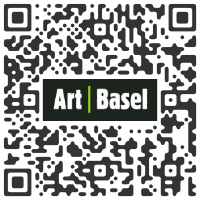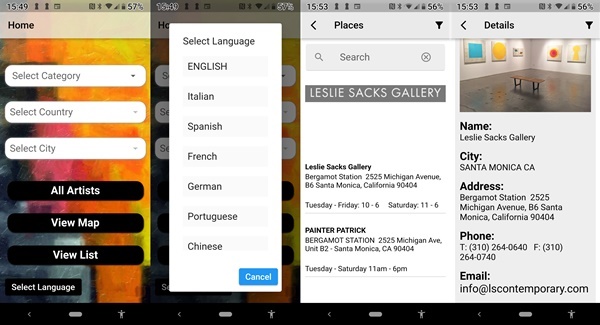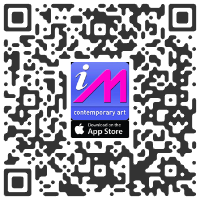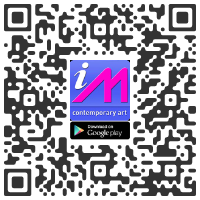"stand J10"
Jaider Esbell, Vivian Caccuri, Emmanuel Nassar, Tunga, Paulo Pasta, Peter Halley, Alex Červený, Ana Amorim, Miguel Rio Branco

GALERIA MILLAN
Rua Fradique Coutinho, 1360 São Paulo, SP Brasil 05416-001Phone: +55 11 3031 60 07 Email




Art Basel Miami Beach 2022
Miami Beach Convention Center 1901 Convention Center Drive Miami Beach, FL 33139+41 58 206 27 06 e-mail:
1 > 3 December, 2022
![click to enlarge- double click to reduce Tunga, sem título [untitled], da série [from the series] Estojo, 2008-2011 (38 x 32 x 20 cm) ft [ph]: Bruno Leão](/mpefm/images/millan/millan_ABMB1.jpg)
![click to enlarge- double click to reduce Alex Červený, Playlist, 2022 (27 x 35 cm) ft [ph]: Ana Pigosso](/mpefm/images/millan/millan_ABMB2.jpg)
![click to enlarge- double click to reduce Maya Weishof, The sun was not so true, 2022 (158 x 132 cm) ft [ph]: Ana Pigosso](/mpefm/images/millan/millan_ABMB3.jpg)
![click to enlarge- double click to reduce Paulo Pasta, sem título [untitled], 2022 (160 x 120 cm) ft [ph] : Ana Pigosso](/mpefm/images/millan/millan_ABMB4.jpg)
![click to enlarge- double click to reduce Jaider Esbell, Ninho dos sonhos, 2021 (70 x 70 cm) ft [ph]: Ana Pigosso](/mpefm/images/millan/millan_ABMB5.jpg)
![click to enlarge- double click to reduce Elena Damiani, Transits and occultations III, 2021 (dimensões variáveis) [variable dimensions] (4 peças de [4 pieces of] 19 x 14,5 x 108 cm) ft [ph]: Bruno Leão](/mpefm/images/millan/millan_ABMB6.jpg)
![click to enlarge- double click to reduce Emmanuel Nassar, série [series] Chapas,2022 (90 x 90 cm) (cada) [each] ft [ph]: Ana Pigosso](/mpefm/images/millan/millan_ABMB7.jpg)
![click to enlarge- double click to reduce Ana Amorim, Difficult Simplification, 2021 (67,5 x 65,7 x 5 cm) ft [ph]: Ana Pigosso](/mpefm/images/millan/millan_ABMB8.jpg)
![click to enlarge- double click to reduce Peter Halley, Between Two Worlds, 2021 (253 x 260 cm) ft [ph]: Filipe Berndt](/mpefm/images/millan/millan_ABMB9.jpg)
stand J10
For Art Basel Miami Beach 2022, Millan presents a selection of artists whose practices engage in pressing contemporary issues, while advancing debates on art in a global context.
The reassessment of official narratives in the face of decolonial views, the urgency of environmental preservation and the flaws in the models of western societies based on technological development have been addressed in several exhibitions around the world and are featured in works by artists such as Jaider Esbell, Vivian Caccuri and Emmanuel Nassar.
In view of the various ruptures currently faced, there is also the search for ways of understanding and representing reality that escape rationality and instead focus on the subconscious, in the creation of narratives, and in the power of sensory experiences, as proposed by the works of Tunga, Paulo Pasta, Peter Halley and Alex Červený. Artists Ana Amorim and Miguel Rio Branco have unique ways of representing daily life and social struggle, be it through their own experience, as in the daily register of routine carried out by Amorim, or through sensitive and attentive regard, as in the work of Rio Branco.
Jaider Esbell (Brazil, 1979 - 2021), a visual artist, writer and educator of the Macuxi ethnic group, has created an artistic practice permeated by activism in defense of the rights of native populations and the environment. His works represent the Macuxi worldview and counterpoint the organizational forms of Western societies, providing alternatives to understanding global issues in the Anthropocene. His practice has gained international acclaim in the past years, following his participation in the 59th Venice Biennale, the 34th São Paulo International Biennial and this year’s La Triennale di Milano.
Also present in Mondo Reale at the Triennale di Milano, the work of Alex Červený (Brazil, 1963) builds images that draw on the fantastic universe of literature, myths, and surrealism, as well as on references to pop music and television, creating narrative landscapes which shed light on environmental, political, and social themes.
Pop culture and music also appear in the work Lava IV (2022), by Vivian Caccuri (Brazil, 1986), who uses a mosquito net as a base on which she creates drawings using sewing threads, embroidery, and beads, creating an object which, when activated by the wind, produces its own sound. Caccuri is currently on view in the show The Shadow of Spring, in collaboration with Miles Greenberg, at the New Museum, New York.
With humor and irony, Emmanuel Nassar (Brazil, 1949) appropriates discarded metal pieces and paints on them different logos of global capitalism, in a blunt commentary on technocracy, mass consumer culture and relations of subalternity between the global south and hegemonic centers. Nassar’s Chapas (2009 - 2022) dialogues with the tradition of twentieth-century Brazilian art, in particular constructivism and pop art, which addressed cultural identity and the ideas of progress and underdevelopment.
In an impressionistic and raw manner, Miguel Rio Branco (Spain, 1946) depicts the daily lives of - often marginalized - characters in Brazil and abroad. With a striking use of colors and contrast, his images capture realities in a sensitive and powerful fashion.
With a unique approach to routines, Ana Amorim (Brazil, 1956) has an artistic practice completely intertwined with life itself. In October Vertical Maps (2018), the artist registered mental maps in 3 formats - a written narrative map, a mental map of her routes, and a locator number for the day, for the duration of that month.
Peter Halley (USA, 1953), known for his fluorescent flat abstract paintings that emphasize color and systems, employs the language of geometric abstraction to explore the organization of social space in the digital age. He also performs in his works a dialogue with modern art, using the traditionally contemplative medium of painting to comment on the fragmentation of real experience operated by the digital age and social media.
The power of painting and abstractionism in the mediation of reality is also expressed in the work of Paulo Pasta (Brazil, 1959), one of the leading painters of his generation. Pasta builds rich chromatic fields, which invite the viewer to attentive observation, creating a suspension of everyday time and recovering the ability of art to speak to the senses and to the sublime.
The convergence of metaphysics and artistic experience is a striking aspect of Tunga's (Brazil, 1952 - 2016) work. Using sculpture, installation, drawing, video, and pioneeringly, performance, Tunga’s works offer disconcerting experiences that appeal to the senses and operate on erotic, spiritual, alchemical, physical, and psychoanalytic repertoires. One of the most renowned artists in the country, he was the first Brazilian artist to exhibit at Louvre Museum, in 2004.
For Art Basel, Millan selected two historical works by Tunga: Albinos (1982) first exhibited at the 41st Venice Biennale, as well as a work from the series Palindromo Incesto, key to the artist’s poetics and visual vocabulary, with elements such as needles and thimbles, copper wires, magnets, and iron filings.
For Art Basel Miami Beach 2022, Millan presents a selection of artists whose practices engage in pressing contemporary issues, while advancing debates on art in a global context.
The reassessment of official narratives in the face of decolonial views, the urgency of environmental preservation and the flaws in the models of western societies based on technological development have been addressed in several exhibitions around the world and are featured in works by artists such as Jaider Esbell, Vivian Caccuri and Emmanuel Nassar.
In view of the various ruptures currently faced, there is also the search for ways of understanding and representing reality that escape rationality and instead focus on the subconscious, in the creation of narratives, and in the power of sensory experiences, as proposed by the works of Tunga, Paulo Pasta, Peter Halley and Alex Červený. Artists Ana Amorim and Miguel Rio Branco have unique ways of representing daily life and social struggle, be it through their own experience, as in the daily register of routine carried out by Amorim, or through sensitive and attentive regard, as in the work of Rio Branco.
Jaider Esbell (Brazil, 1979 - 2021), a visual artist, writer and educator of the Macuxi ethnic group, has created an artistic practice permeated by activism in defense of the rights of native populations and the environment. His works represent the Macuxi worldview and counterpoint the organizational forms of Western societies, providing alternatives to understanding global issues in the Anthropocene. His practice has gained international acclaim in the past years, following his participation in the 59th Venice Biennale, the 34th São Paulo International Biennial and this year’s La Triennale di Milano.
Also present in Mondo Reale at the Triennale di Milano, the work of Alex Červený (Brazil, 1963) builds images that draw on the fantastic universe of literature, myths, and surrealism, as well as on references to pop music and television, creating narrative landscapes which shed light on environmental, political, and social themes.
Pop culture and music also appear in the work Lava IV (2022), by Vivian Caccuri (Brazil, 1986), who uses a mosquito net as a base on which she creates drawings using sewing threads, embroidery, and beads, creating an object which, when activated by the wind, produces its own sound. Caccuri is currently on view in the show The Shadow of Spring, in collaboration with Miles Greenberg, at the New Museum, New York.
With humor and irony, Emmanuel Nassar (Brazil, 1949) appropriates discarded metal pieces and paints on them different logos of global capitalism, in a blunt commentary on technocracy, mass consumer culture and relations of subalternity between the global south and hegemonic centers. Nassar’s Chapas (2009 - 2022) dialogues with the tradition of twentieth-century Brazilian art, in particular constructivism and pop art, which addressed cultural identity and the ideas of progress and underdevelopment.
In an impressionistic and raw manner, Miguel Rio Branco (Spain, 1946) depicts the daily lives of - often marginalized - characters in Brazil and abroad. With a striking use of colors and contrast, his images capture realities in a sensitive and powerful fashion.
With a unique approach to routines, Ana Amorim (Brazil, 1956) has an artistic practice completely intertwined with life itself. In October Vertical Maps (2018), the artist registered mental maps in 3 formats - a written narrative map, a mental map of her routes, and a locator number for the day, for the duration of that month.
Peter Halley (USA, 1953), known for his fluorescent flat abstract paintings that emphasize color and systems, employs the language of geometric abstraction to explore the organization of social space in the digital age. He also performs in his works a dialogue with modern art, using the traditionally contemplative medium of painting to comment on the fragmentation of real experience operated by the digital age and social media.
The power of painting and abstractionism in the mediation of reality is also expressed in the work of Paulo Pasta (Brazil, 1959), one of the leading painters of his generation. Pasta builds rich chromatic fields, which invite the viewer to attentive observation, creating a suspension of everyday time and recovering the ability of art to speak to the senses and to the sublime.
The convergence of metaphysics and artistic experience is a striking aspect of Tunga's (Brazil, 1952 - 2016) work. Using sculpture, installation, drawing, video, and pioneeringly, performance, Tunga’s works offer disconcerting experiences that appeal to the senses and operate on erotic, spiritual, alchemical, physical, and psychoanalytic repertoires. One of the most renowned artists in the country, he was the first Brazilian artist to exhibit at Louvre Museum, in 2004.
For Art Basel, Millan selected two historical works by Tunga: Albinos (1982) first exhibited at the 41st Venice Biennale, as well as a work from the series Palindromo Incesto, key to the artist’s poetics and visual vocabulary, with elements such as needles and thimbles, copper wires, magnets, and iron filings.
 | Jaider Esbell | |
 | Vivian Caccuri | |
 | Emmanuel Nassar | |
 | Tunga | |
 | Paulo Pasta | |
 | Peter Halley | |
 | Alex Červený | |
 | Ana Amorim | |
 | Miguel Rio Branco | |
Private Days (by invitation only)
Tuesday, November 29, 2022, 11am to 7pm, First Choice VIP cardholders
Tuesday, November 29, 2022, 4pm to 7pm, Preview VIP cardholders
Wednesday, November 30, 2022, 11am to 7pm, First Choice and Preview VIP cardholders
Vernissage (by invitation only)
Wednesday, November 30, 2022, 4pm to 7pm
Tuesday, November 29, 2022, 11am to 7pm, First Choice VIP cardholders
Tuesday, November 29, 2022, 4pm to 7pm, Preview VIP cardholders
Wednesday, November 30, 2022, 11am to 7pm, First Choice and Preview VIP cardholders
Vernissage (by invitation only)
Wednesday, November 30, 2022, 4pm to 7pm
mpefm
USA fair art press release
Public days:
Thursday, December 1, 2022, 11am to 7pm
Friday, December 2, 2022, 11am to 7pm
Saturday, December 3, 2022, 11am to 6pm
TICKET OPTIONS*
Tickets may be purchased online here. Tickets can also be purchased at the box office in the West Lobby of the Miami Beach Convention Center, beginning December 5, 2022.
First Access Ticket USD 90
Day Ticket USD 70
Reduced Day Ticket USD 55
For students and seniors.
Premium Card USD 600
Premium+ Card USD 2200
Art Basel & Design Miami Combination Ticket USD 98

Thursday, December 1, 2022, 11am to 7pm
Friday, December 2, 2022, 11am to 7pm
Saturday, December 3, 2022, 11am to 6pm
TICKET OPTIONS*
Tickets may be purchased online here. Tickets can also be purchased at the box office in the West Lobby of the Miami Beach Convention Center, beginning December 5, 2022.
First Access Ticket USD 90
Day Ticket USD 70
Reduced Day Ticket USD 55
For students and seniors.
Premium Card USD 600
Premium+ Card USD 2200
Art Basel & Design Miami Combination Ticket USD 98
QR of this press release
in your phone, tablet













